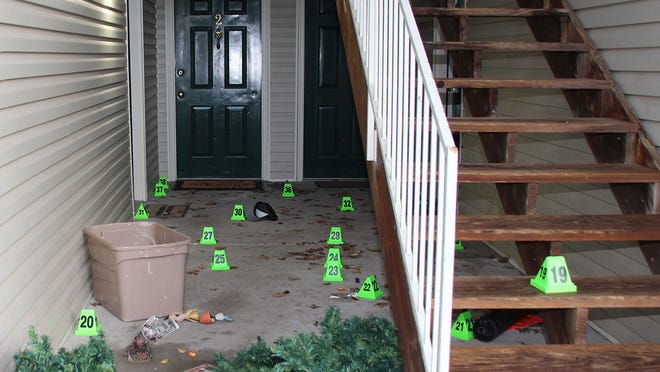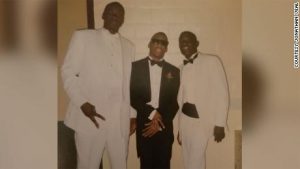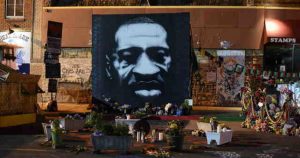LOUISVILLE, Ky. — The Louisville sergeant investigating the officers in the fatal shooting of Breonna Taylor questioned whether they purposely downgraded the risk of searching her home so they could exclude SWAT.
While interviewing the officers who broke down Taylor’s door in a raid that ended in her death, Sgt. Andrew Meyer of the Professional Standards Unit pressed them on “obvious and seemingly blatant omissions” on the risk assessment form they filled out before the raid.
“The exclusions of these certain pieces of information made the document appear deceptive,” Meyer told one of the officers he was questioning.
As the name implies, the risk assessment matrix helps gauge the potential danger involved in a prospective search. The higher the score on the form, the greater the potential risk.
But the assessment for Taylor’s apartment was scored just low enough to avoid a required consultation with SWAT before the search was carried out, according to a copy of the document The Courier Journal, a part of the USA TODAY Network, obtained in an open-records request.
Indeed, in his final report, Sgt. Meyer — the same investigator who concluded officers shouldn’t have fired a “single shot” in Taylor’s apartment — stated even a “conservative estimate” of the risk should have prompted officers to get input from Louisville Metro Police Department’s SWAT team before going in.
Had a consultation happened, the SWAT team might have suggested a different approach to Taylor’s apartment, particularly since SWAT leaders already had told officers not to do the search the same night they were searching other homes miles away as part of their narcotics investigation.
Seven plainclothes officers went to Taylor’s apartment shortly before 1 a.m. on March 13, 2020, knocked and then broke into the door. Taylor’s boyfriend fired one shot from his legally owned handgun when the door burst in, hitting a sergeant in the leg.
One year later:Photos show a racial reckoning after George Floyd’s death
Related story:On anniversary of George Floyd’s murder, President Biden to meet with family after missing deadline for police reform
Three officers fired 32 shots in response, killing Taylor, who was unarmed, in her hallway. Taylor’s boyfriend later said he thought an intruder was breaking in.
The officers Meyer questioned bristled at his line of questioning, insisting they weren’t trying to avoid SWAT.
“If SWAT wanted to do this, by all means, I want them to do this,” detective Wes Barton, who filled out the document, told Meyer. “I want everyone to go home safe.”
Ultimately, Meyer’s investigation resulted in no conclusive findings whether there was an intent to mislead or exclude SWAT.
But his questions and the inaccuracies in the risk assessment itself raise questions about the intelligence gathered by police in the Place-Based Investigations unit and others on-scene before they raided Taylor’s apartment.
Despite surveillance of the apartment, police failed to anticipate that Taylor’s boyfriend, Kenneth Walker, would be in the apartment or carrying a gun.
Intelligence also appears to have missed that Taylor’s younger sister lived with her, that Taylor often cared for a child in the home and that she and the narcotics investigation’s main target, ex-boyfriend Jamarcus Glover, had drifted apart.
Any of those pieces of information might have raised the risk assessment score, requiring a SWAT consultation or having SWAT carry out the search itself.
“I sincerely hope that the FBI in their investigation might close some of the gap here,” Chief Erika Shields told NBC Nightly News on Tuesday. “I have very real concerns about how the (search) warrant was drawn up.”
The matrix for Taylor’s apartment was scored at 15 points, putting it in the category of minimal risk.
Between 17 and 27 points is considered medium risk and requires a SWAT consult. Twenty-eight or more points is a high-risk search that must be carried out by SWAT.
In Meyer’s assessment, the matrix for Taylor’s home should have included another 25 points for a total of 40, which would have mandated SWAT service.
In his questioning of the officers, Meyer pressed his point, focusing on specific questions that might have raised the risk, such as:
- Who did officers expect to find inside Taylor’s apartment?
- Why didn’t the risk assessment form indicate they had secured a search warrant with a “no-knock” provision?
- Was Taylor a suspect in the narcotics investigation?
- Was her ex-boyfriend, Jamarcus Glover, the main target, a “Class 1 drug violator,” raising the risk?
‘I would’ve advised them 100% not to do it until we were done’
While seven officers gathered outside Taylor’s door that night, SWAT officers were preparing to search three houses about 10 miles away in the Russell neighborhood where Glover and his associates were suspected of selling drugs.
SWAT Lt. Dale Massey told investigators he warned the officers days earlier against serving simultaneous warrants, calling them “bad business.”
But Massey said Taylor’s apartment was never mentioned at a briefing held the day the warrants were served, nor did he see the risk assessment or operations plan for that address.
“I would’ve advised them 100% not to do it until we were done doin’ what we had to do,” Massey said.
Six of the seven officers who were at Taylor’s apartment the night of her killing knew little or nothing about the underlying investigation.
More:3 Georgia men who chased, shot Ahmaud Arbery plead not guilty to hate crime charges
Only one, Detective Mike Campbell, who was responsible for surveilling the apartment and is a part of the PBI unit, said he had seen the risk assessment before the raid.
Lt. Shawn Hoover, the ranking officer on scene, told investigators he assumed the assessment had been done.
“I say that, but I did not see one,” he said. “I guess that’d be an error on me for not askin’ that question.”
Risk assessment:Read the annotated report.
Was SWAT kept out of the loop?
Officers insisted there was no attempt to exclude SWAT, noting a consultation a week earlier in which the overall operation was discussed and SWAT was able to weigh in.
Detective Joshua Jaynes, who wrote and secured the search warrants for the investigation, followed up that meeting with an email to a SWAT sergeant that included an affidavit for Taylor’s apartment and other locations.
“SWAT was involved in this investigation,” Jaynes told Meyer. “I would gain nothing from this to omit something from this (risk assessment) matrix, something that they were involved in.”
Barton, the Place-Based unit detective who filled out the document, said his takeaway from the meeting with SWAT was, “they did suggest doing things at a different time. I did not know they said they would not do it at the same time.”
Barton said he wasn’t trying to lower the matrix’s score.
“I have no intentions of making this fluffed or whatever,” he told Meyer. “It’s not worth it.”
Sgt. Kyle Meany, head of the Place-Based Investigations unit, pushed back against allegations of an artificially lowered score, arguing: “If the implication is that we are trying to drive the score down to not have SWAT serve it, why would I have SWAT serve warrants on Elliott the same night?”
In several interviews, Meyer pushed back
He noted detectives might have wanted to make sure they could search Taylor’s apartment simultaneously with the suspected drug houses because of a risk of “tampering.”
In other words, if the other homes were raided before Taylor’s apartment, any evidence there could have been destroyed before officers arrived.
Meany, the Place-Based commander, concurred that hitting all the locations was important, telling Meyer it’s necessary to “essentially get everything at once so that there’s not movin’ evidence or, you know destroying evidence.”
So is that why the warrant for Taylor’s apartment wasn’t served later? Because “if you didn’t, there goes the evidence?” Meyer asks.
“Correct,” Meany responded.
Neither drugs nor cash were recovered from Taylor’s home after the shooting.
Was Breonna Taylor a suspect?
One factor that could have increased the score on the risk-assessment matrix: Whether Taylor herself was a suspect in the investigation.
Though she was listed by name on the search warrant for her home, the matrix did not count her as a suspect, but rather as “additional persons on-site.” That lowered the matrix score.
Meyer asked several officers in interviews whether Taylor was a suspect. All told him no.
Meany said officers “didn’t quite understand her involvement” in the narcotics operation they believed involved Glover, her ex-boyfriend.
“We would be jumpin’ to a conclusion to say that she’s a suspect,” Meany said.
Jaynes said in a search warrant affidavit — which resulted in Jaynes’ termination for his lack of truthfulness earlier this year — officers saw Glover picking up a package from Taylor’s apartment.
The affidavit noted Glover’s car frequently was at her apartment.
Barton said even if Glover was using Taylor’s address to receive contraband, that didn’t mean Taylor knew about it.
“So I do not consider that her being a suspect, because she can be oblivious to what’s going on but still … allowing illegal activity to occur in her house,” he said.
Campbell said Taylor was never seen handling or trafficking drugs, but “she was around a lot of people who were.”
“We really wanted to talk to her mostly,” he said, adding they may have sought to establish her as an informant.
At times, the officers contradicted each other about the final assessment of the risk at Taylor’s apartment. Barton said it was based on the “worst-case scenario” of Glover being at the apartment; Campbell said it was filled out as if Taylor was home alone because they knew Glover would be elsewhere.
Meyer ultimately disagreed with the officers’ assessment, writing that Taylor fit the category of a narcotics trafficking suspect based on the probable cause affidavit for the search.
COVID-19:Deaths by suicide declined at the height of the pandemic. Researchers have some ideas why.
Including Taylor as a suspect would have added another five points to the risk assessment and required consulting SWAT.
The murkiness of interpretation
There were other factors that could have tipped the scales toward involving SWAT in the search warrant.
Meyer also hammered away at: the no-knock clause on the search warrant; two other people, Glover and his associate Adrian Walker, on the warrant for Taylor’s apartment; and Glover’s lengthy history of drug arrests.
Barton told investigators he did not consult records when filling out the matrix, basing it instead on his understanding of Glover’s criminal history.
That left some categories up to interpretation, making the scoring subjective.
For example, the form advises officers to add five points to the risk if a “Class 1 drug violator” is a suspect. Glover might have qualified, according to Meyer.
Barton didn’t articulate a clear understanding of what a “Class 1 drug violator” would include, describing it as a “cartel member, someone who’s moving a large amount of drugs, not someone who’s been charged with it multiple times.”
So Barton didn’t add the 5 points — again keeping the overall score below the threshold requiring a SWAT consultation.
Meyer disagreed with PBI officers’ assessment of Glover’s criminal history. They argued Glover wouldn’t be a “Class 1 drug violator,” because he didn’t deal in large quantities of narcotics at a given time.
LMPD policy defines a Class 1 violator as someone trafficking a kilogram or more, but Meyer noted it doesn’t say over what time span.
He also pointed out police obtained a warrant with a no-knock provision, which should have added 15 points to the risk assessment. Officers said they didn’t add those points because they had decided to knock and announce themselves at Taylor’s door.
Meyer said had the warrant been taken at face value, the additional risk should have been included on the assessment.
‘Apparent flaws’ in matrix policy leave details up for debate
Meyer pointed out these things as oversights in the assessment, but the PBI officers noted them as policies open to interpretation. Whereas Meyer saw things one way, the PBI officers said they saw them another.
“It’s a permission slip,” Jaynes told him, “not a plan of action.”
LMPD’s policy and matrix form are vague enough to allow different interpretations, Meyer notes in a report to his superiors.
Most serious of its “apparent flaws,” he noted, is the “responsibility and accountability for the completion of the form.” While policy says a risk assessment must be done before all search warrants are carried out, it “does not place the responsibility on a specific actor.”
“Ultimately, the risk assessment matrix was completed for this event,” Meyer wrote. “The accountability for the omissions which made the document deceptive will rest on those responsible for the document’s creation and submission.”
Follow Tessa Duvall and Darcy Costello on Twitter: @TessaDuvall and @dctello.
Breaking down the risk matrix:
Location factors: These circumstances consider security on the premises and who else may be present during a search.
- Multiple suspects: In addition to Jamarcus Glover, Breonna Taylor and an associate of Glover’s, a man named Adrian Walker (no relation to Kenneth Walker), were named on the search warrant; Walker was a legitimate suspect but officers involved in the investigation all said Taylor was a “person of interest” — not a suspect. Sgt. Andrew Meyer, the officer investigating the March 13 shooting for standards violations, disagreed, saying the evidence gathered on Taylor would fit the definition of suspected narcotics trafficking. (Not checked; five points.)
- Additional people on-site: Meyer argued even if Taylor was counted as a suspect, detectives still should have known Taylor’s younger sister lived at the same apartment and would therefore count as an additional person. (Checked; five points.)
- Video surveillance: Officers used similar language in requesting five search warrants on March 12, including a line about “the nature of how these drug traffickers operate,” including “cameras on the location that compromise detectives” on approach. Despite that language being used on the warrant for Taylor’s apartment, the “video surveillance” box is unmarked, though it was checked for 2424 Elliott and 2605 W. Muhammad Ali Blvd. (Not checked; 10 points.)
- No-knock warrant: Despite having a no-knock search warrant signed by Circuit Judge Mary Shaw, officers did not check the “no-knock warrant” box for Taylor’s apartment. Officers told Meyer they planned to execute the warrant as a knock-and-announce, and department policy didn’t require them to check the box in that case. (Not checked; 15 points.)
Criminal history: The matrix also takes into consideration the criminal history of involved suspects. Points are added for select previous charges against each suspect.
- Class 1 drug violator: Detectives argued Glover did not fit this criteria because he had not been accused of moving large enough quantities of drugs. Meyer notes as a “career narcotics trafficker … would quickly qualify” for this criteria. But, the policy is vague and does not specify if this is over the span of a single investigation, a totality of arrests or a single incident. Glover has faced multiple arrests for drugs and served prison time in Mississippi for selling cocaine. (Not checked; five points.)
- Firearms/CCDW: As a convicted felon, Glover is not legally allowed to have a gun, but he had been charged with felon in possession of a firearm or a handgun in 2019 and 2016. (He was also charged with those offenses for March 13, 2020, too.) The charges in each instance have been dismissed or a grand jury returned a no true bill. (Checked; five points.)



















